Inclusive professionalism in FE and Skills: the power of stories | Part 2

In part two of this inclusive professionalism ‘in conversation’ series with Dr Vikki Smith, Executive Director of Education and Standards at the Education and Training Foundation (ETF), and Ellisha Soanes, Equity, Diversity and Inclusion (EDI) consultant, Vikki and Ellisha discuss the power of stories and self-reflection in driving inclusive professionalism and building an inclusive curriculum.
How do we bring different perspectives into professional practice?
ES: We’ve talked about social mobility here in PART 1, and the positive knock-on effects of building confidence and enabling learners to find their strengths and build their unique path. I often talk about the power of stories in helping people on this journey. We need to gather the many powerful stories from different communities and groups and channel those towards inclusive leadership and training – and think about how we bring those stories into the classroom. Telling different stories gives people that moment where they think ‘I can do it’. And that applies from the youngest learners to everyone beyond that, because those positive messages are continuously reinforced.
VS: Given how our landscape is changing all the time if we were all modelled in the same way, the world wouldn’t keep moving. We need people with different perspectives, different experiences, different heritages, different views of the world. Only then can we be innovative, be creative, and find solutions. If we didn’t have that multiplicity of perspectives, we would just keep doing the same old, same old. By having different creative viewpoints, we find new ways to achieve – and achieve differently, as well, which has to be a good thing.
And your point about storytelling is really important because it is through stories and storytelling that we empower people, and stimulate their imagination. We give them a sense that things are possible, and that stimulates their response to change, and keeps things moving.
What does inclusive professionalism look like?
ES: An inclusive professional workforce, for me, starts with training and development. It’s so important to have training in place because people come from different walks of life and we all come with biases. That’s not a bad thing but it’s important to recognise – and we need to understand those biases and unpick them through self-reflection. Having a safe space, a sense of belonging, and empowerment is also so important. You need to feel like your voice is heard. When you have that supportive environment, it creates a ripple effect.
VS: For me, inclusive professionalism is about respect and values. And that means acknowledging our biases and thinking about how that plays out in the workplace, in the classroom, in the workshop. How do I make sure that I’m not bringing those biases into my teaching session, into my interactions with my colleagues? I can only do that through gaining knowledge, and through asking, engaging and challenging myself so that I value all the different contributions that everyone is bringing into the professional workspace. The cornerstone of that approach has to be respect. That is a cornerstone for the whole equity, diversity, inclusion and belonging (EDIB) agenda. But it’s got to be the cornerstone for professionalism as well.
If we create the right environment built on respect and shared values, it enables people to flourish. Your point about a work environment being a safe space is also really important. We need to create an environment where people can be confident in their strengths, but also be vulnerable and open about their weaknesses. People can only be open in that way when they feel supported and have that sense of belonging, which is critical.
How do we build an inclusive curriculum?
ES: When I provide training on black history one of my first questions is ‘Were you taught black history in school?’ As educators, we often weren’t – and nine times out of 10, if people were, the topics were either slavery or the civil rights movement. So, we need to reflect on that. How will teaching those specific parts of the curriculum make our learners feel? What does teaching only those parts of black history say to learners about a specific group of people? If we unpick the curriculum and broaden it out – talk about the Windrush generation’s contributions to British society, for example, or the lives of black Tudors – many illuminating conversations come from that. And that all comes from self-reflection, and examining our biases. We have to start with ourselves and our training and development, then build on that towards inclusivity in the curriculum and beyond.
VS: How do we enable people to see themselves or elements of themselves so that they can truly feel like they belong? When it comes to pedagogy and to the curriculum, we need to be inclusive and representative. What we are taught should demonstrate the roundedness of the world in which we live, because the world is diverse and we need to bring all of that into the learning environment and help people recognise the beauty of that.
The more diverse the learning environment is, the more creative we will be. We’ll be more resilient and better able to adapt to change because we’ll recognise there is never just one way to do something. So it’s that belonging, role modelling, seeing ourselves and having that represented through the curriculum. And that will be more compelling from a learning perspective too, meaning people are more likely to enjoy their learning and succeed in whatever they do.
By Dr Vikki Smith, Executive Director of Education and Standards at the Education and Training Foundation (ETF), and Ellisha Soanes, Equity, Diversity and Inclusion (EDI) consultant.











Responses